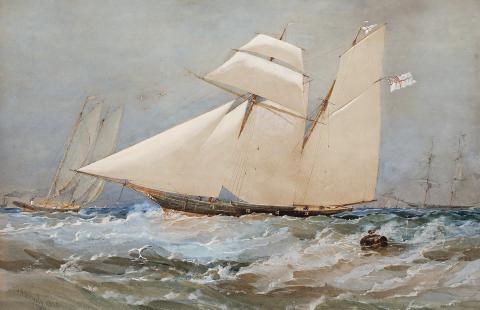THE WANDERER, ROYAL YACHT SQUADRON, 1840
OSWALD BRIERLY
watercolour and gouache on paper
46.5 x 72.0 cm
signed and dated lower left: O W Brierly 1840
Private collection, United Kingdom
Christie’s South Kensington, London, 7 July 2016, cat. 222
Private collection, Melbourne
Wanderer. Benjamin Boyd Esq and Brig Yacht Wanderer. Benjamin Boyd Esq, c.1840, a pair of lithographs, hand coloured, 32.0 x 47.0 cm and 32.0 x 45.0 cm, drawn and lithographed by Oswald Brierly, Day & Haghe, lithographers to the Queen, published by Edmund Fry, London, and Edmund Fry Jnr., Plymouth
The British mastery of watercolour is seen at its best in Oswald Brierly’s The Wanderer, Royal Yacht Squadron, 1840. Wind and white waves echo in the billowing sails as RYS Wanderer rides the waters in majesty. Few can rival the genius of Brierly’s marine subjects, as seen again to brilliant effect in Whalers off Twofold Bay, New South Wales, 1867, in the collection of the Art Gallery of New South Wales.
Brierly, Benjamin Boyd and the Wanderer share absorbing histories. Brierly studied art in London and naval architecture at Plymouth, meeting Boyd of the Royal Yacht Squadron. Wanderer was part of the Squadron. In about 1840, Edmund Fry & Son, of London and Plymouth, published a pair of lithographs showing the yacht in full sail, from port and starboard sides.1 The similarity between the lithograph of the portside and our watercolour suggests that it was a study or closely related earlier work for the print. The brown ink drawing, The Wanderer, provides another, being a view of the stern and different tack.2 In our watercolour, the Wanderer flies the White Ensign of the Royal Navy, permitted only to members of the Royal Yacht Squadron, its pennant burgee at masthead.3
In 1841, Brierly joined Boyd aboard the Wanderer, voyaging to Australia. As she sailed up Port Jackson in July of 1842, crowds gathered on the heights in greeting and the schooner Velocity fired a salute. Brierly spent some years at Twofold Bay, near Eden, managing Boyd’s pastoral and whaling businesses. He also completed further studies of the Wanderer at Sydney in 1846, a wood engraved image after Brierly appearing in the Illustrated London News of 10 April 1852.4
Boyd became one of the largest landholders in the colony before his spectacular entrepreneurial enterprises bought him undone. Sailing off into history and mystery, he left Sydney on the Wanderer in October 1849, seeking a new fortune on the Californian goldfields. Unsuccessful, he disappeared on the island of Guadalcanal in October 1851. His body was never found, leading to rumours that he was still alive. The Wanderer continued to Australia, wrecked off Port Macquarie shortly after.
Brierly’s separate adventures were just beginning. In 1848, he joined Captain Owen Stanley on HMS Rattlesnake on a survey of the Great Barrier Reef, Louisiade Archipelago and part of coastal New Guinea. At the invitation of commander (later admiral) Henry Keppel, Brierly joined HMS Meander, returning to England round the Horn in 1851. During the Crimean War Brierly rejoined Keppel in the Baltic fleet, making sketches of naval activities for the Illustrated London News. Royal patronage followed when commanded by Queen Victoria to sketch the great 1855 naval review at Spithead. Later appointed official marine painter to the Queen and the Royal Yacht Squadron, he received a knighthood in 1885. Agreeable of personality and companionship, Briely’s second visit to Australia was as guest of the Queen’s son, the Duke of Edinburgh on HMS Galatea during its 1866 voyage around the world. It was one of several voyages undertaken with the Duke. Brierly was greatly admired for the accuracy of his delineation and elegant degree of finish enveloped in an atmosphere of salty sea air, as seen so superbly in The Wanderer, Royal Yacht Squadron.
1. Examples of are in the Nan Kivell Collection of the National Library of Australia, Canberra, and the Mitchell Library, State Library of New South Wales
2. The Wanderer, c.1842, brown ink on paper, 12.3 x 19.4 cm, signed with initials and inscribed beneath the image, ‘The Wanderer’
3. In the previously mentioned lithographs the Wanderer variously carries the White and Red Ensigns of merchant and other registered British vessels. The variations result from them being hand painted.
4. Nan Kivell Collection, National Library of Australia, Canberra, NK6873 and NK4182/19
DAVID THOMAS
